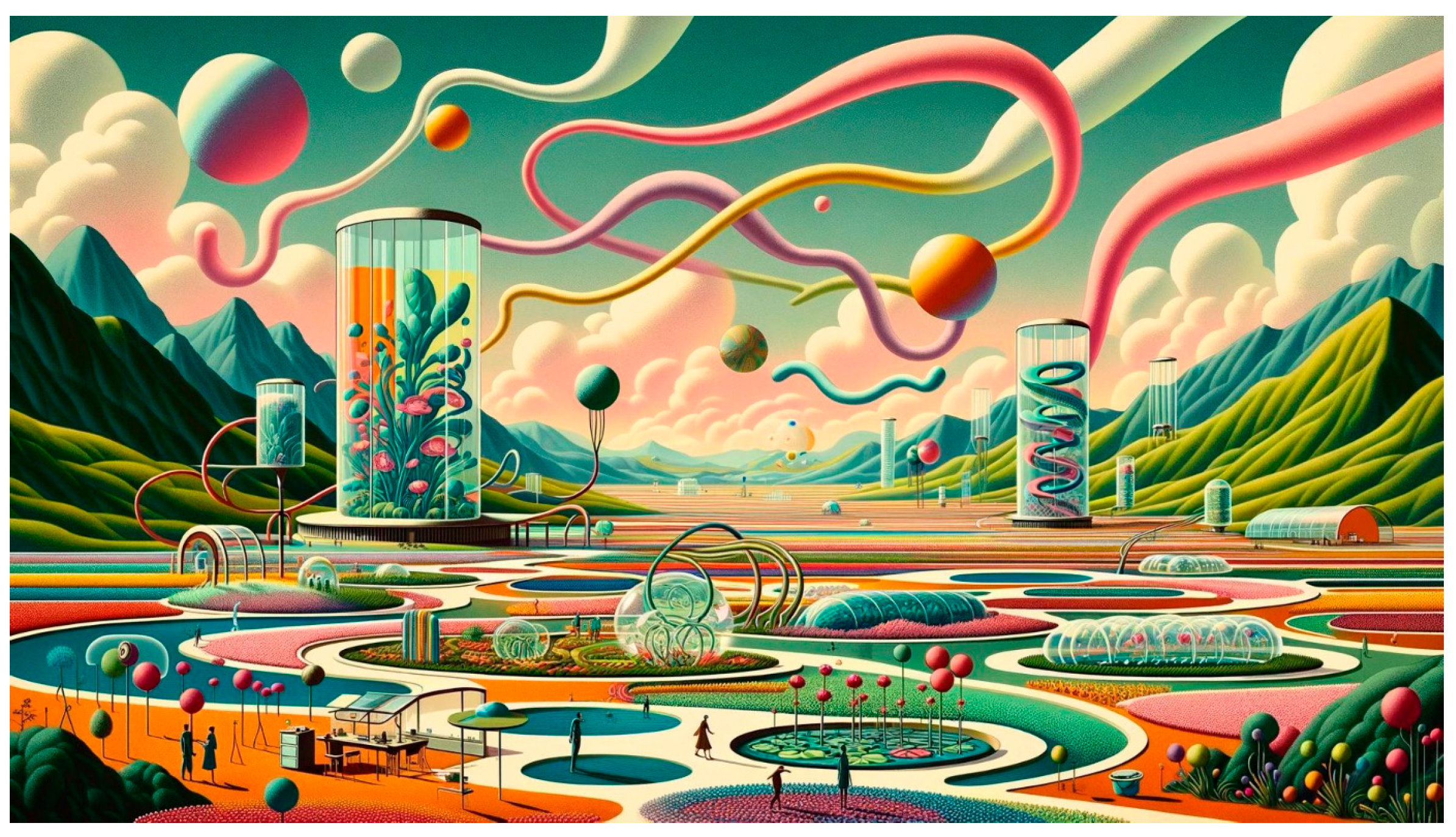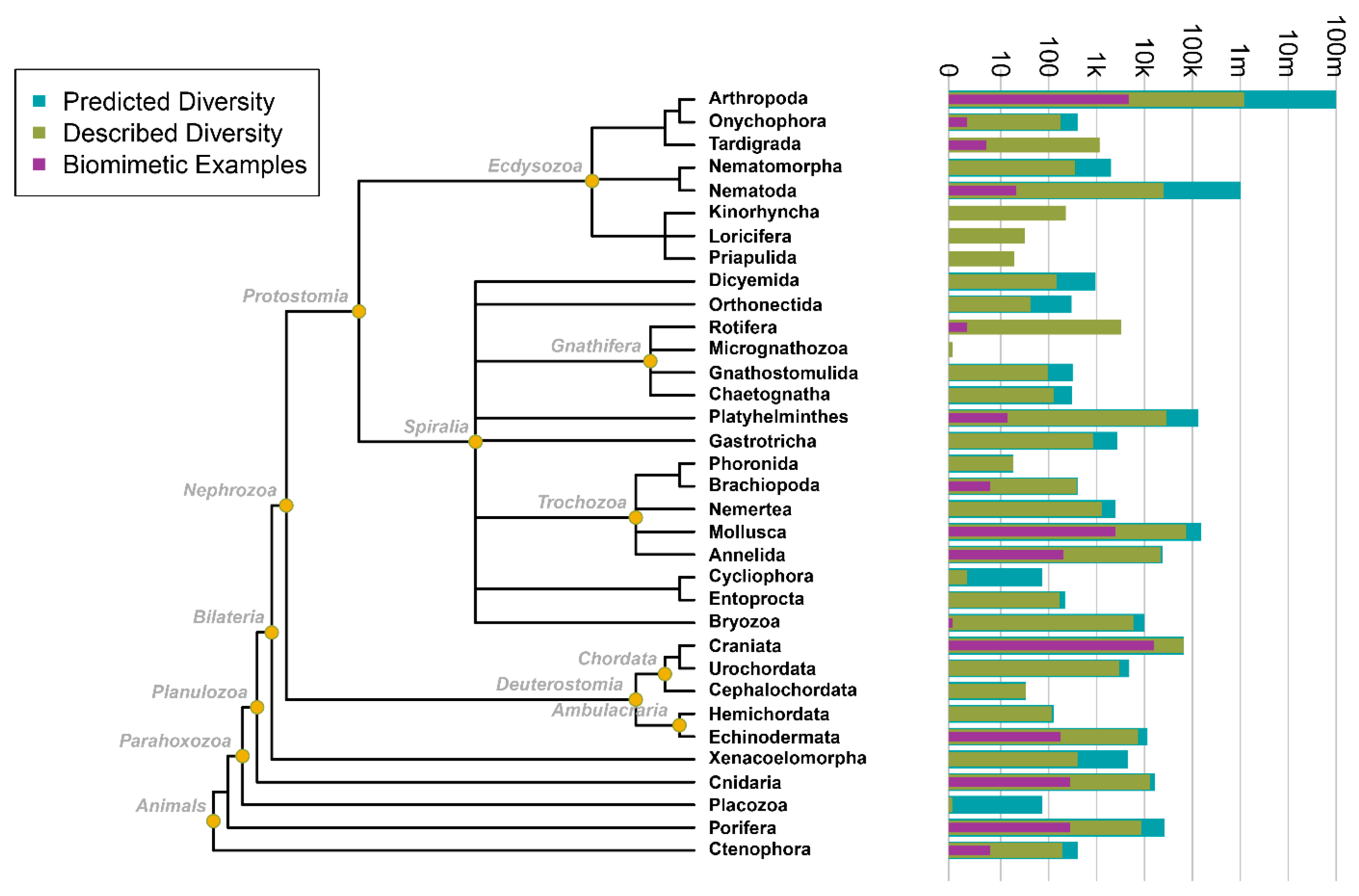A Call for Bio-Inspired Technologies: Promises and Challenges for Ecosystem Service Replacement
Abstract
1. Planetary Boundaries and Ecosystem Services
2. Soil as an Example—A Provisioning ES
3. Biodiversity as a Model
4. Transdisciplinary Teamwork
Author Contributions
Funding
Institutional Review Board Statement
Informed Consent Statement
Data Availability Statement
Conflicts of Interest
Abbreviations
| ES | Ecosystem Services |
| LLM | Large Language Model |
| MEco | Manufactured Ecosystems |
References
- Ecosystems and Human Well-Being: Synthesis; Island Press: Washington, DC, USA, 2005.
- United Nations Department of Economic and Social Affairs (UN DESA). The Sustainable Development Goals Report 2023: Special Edition; United Nations Department of Economic and Social Affairs (UN DESA): New York, NY, USA, 2023; Available online: https://unstats.un.org/sdgs/report/2023/ (accessed on 28 August 2025).
- Richardson, K.; Steffen, W.; Lucht, W.; Bendtsen, J.; Cornell, S.E.; Donges, J.F.; Drüke, M.; Fetzer, I.; Bala, G.; von Bloh, W.; et al. Earth beyond six of nine planetary boundaries. Sci. Adv. 2023, 9, eadh2458. [Google Scholar] [CrossRef]
- Kolbert, E. The Sixth Extinction: An Unnatural History; Henry Holt and Company: New York, NY, USA, 2014. [Google Scholar]
- Dicks, L.V.; Breeze, T.D.; Ngo, H.T.; Senapathi, D.; An, J.; Aizen, M.A.; Basu, P.; Buchori, D.; Galetto, L.; Garibaldi, L.A.; et al. A global-scale expert assessment of drivers and risks associated with pollinator decline. Nat. Ecol. Evol. 2021, 5, 1453–1461. [Google Scholar] [CrossRef] [PubMed]
- Fitter, A.H. Are Ecosystem Services Replaceable by Technology? Environ. Resour. Econ. 2013, 55, 513–524. [Google Scholar] [CrossRef]
- Jafferis, N.T.; Helbling, E.F.; Karpelson, M.; Wood, R.J. Untethered flight of an insect-sized flapping-wing microscale aerial vehicle. Nature 2019, 570, 491–495. [Google Scholar] [CrossRef]
- Jacobs, S.; Porter, E.; Dowhaniuk, D.; Lipton, M.; Bazely, D.; Smith, M.A.; Zampaki, N.; Karpouzou, P.; Eggermont, M.; Helms, M.; et al. Can Manufactured Ecosystems fully replace ecosystem services? Zygote Q. 2024, 35, 40–53. [Google Scholar]
- Benyus, J.M. Biomimicry: Innovation Inspired by Nature; HarperCollins: New York, NY, USA, 2002. [Google Scholar]
- Broeckhoven, C.; Winters, S. Biomimethics: A critical perspective on the ethical implications of biomimetics in technological innovation. Bioinspir. Biomim. 2023, 18, 053001. [Google Scholar] [CrossRef] [PubMed]
- Sprunger, C. Deteriorating soil health: ‘A teaspoon of soil contains more life than there are humans on earth’. Open Access Gov. 2022, 36, 442–443. [Google Scholar] [CrossRef]
- Zoka, M.; Lladó, S.; Stathopoulos, N.; Kokkalidou, M.; Ventura, A.M.; Stringer, L.C.; Baarsma, B.; Trakal, L.; Gorfer, M.; Codina, S. Preliminary assessment of the knowledge gaps to reduce land degradation in Europe. Soils Eur. 2024, 1, e119137. [Google Scholar] [CrossRef]
- Panagos, P.; Broothaerts, N.; Ballabio, C.; Orgiazzi, A.; De Rosa, D.; Borrelli, P.; Liakos, L.; Vieira, D.; Van Eynde, E.; Navarro, C.A.; et al. How the EU Soil Observatory is providing solid science for healthy soils. Eur. J. Soil Sci. 2024, 75, e13507. [Google Scholar] [CrossRef]
- Ontl, T.A.; Schulte, L.A. Soil Carbon Storage. Nat. Educ. Knowl. 2012, 3, 35. [Google Scholar]
- Pokhrel, Y.; Felfelani, F.; Satoh, Y.; Boulange, J.; Burek, P.; Gädeke, A.; Gerten, D.; Gosling, S.N.; Grillakis, M.; Gudmundsson, L.; et al. Global terrestrial water storage and drought severity under climate change. Nat. Clim. Chang. 2021, 11, 226–233. [Google Scholar] [CrossRef]
- Anthony, M.A.; Bender, S.F.; van der Heijden, M.G.A. Enumerating soil biodiversity. Proc. Natl. Acad. Sci. USA 2023, 120, e2304663120. [Google Scholar] [CrossRef]
- ISO 18458; Biomimetics—Terminology, Concepts and Methodology. ISO: Geneva, Switzerland, 2015.
- Li, X.; Wiens, J.J. Estimating Global Biodiversity: The Role of Cryptic Insect Species. Syst. Biol. 2023, 72, 391–403. [Google Scholar] [CrossRef]
- Hund, A.K.; Stretch, E.; Smirnoff, D.; Roehrig, G.H.; Snell-Rood, E.C. Broadening the Taxonomic Breadth of Organisms in the Bio-Inspired Design Process. Biomimetics 2023, 8, 48. [Google Scholar] [CrossRef]
- Jacobs, S.R.; Nichol, E.C.; Helms, M.E. “Where Are We Now and Where Are We Going?” The BioM Innovation Database. J. Mech. Design 2014, 136, 111101. [Google Scholar] [CrossRef]
- Snell-Rood, E. Interdisciplinarity: Bring biologists into biomimetics. Nature 2016, 529, 277–278. [Google Scholar] [CrossRef]
- Dunn, C.W.; Giribet, G.; Edgecombe, G.D.; Hejnol, A. Animal Phylogeny and Its Evolutionary Implications. Annu. Rev. Ecol. Evol. Syst. 2014, 45, 371–395. [Google Scholar] [CrossRef]
- Zhang, J.; Baeckens, S.; Van Damme, R.; Wanieck, K. Overlooked sources of inspiration in biomimetic research. Sci. Rep. 2025, 15, 25590. [Google Scholar] [CrossRef] [PubMed]
- Greipsson, S. Phytoremediation. Nat. Educ. Knowl. 2011, 3, 7. [Google Scholar]
- Lepora, N.F.; Verschure, P.; Prescott, T.J. The state of the art in biomimetics. Bioinspir. Biomim. 2013, 8, 013001. [Google Scholar] [CrossRef]
- Fayemi, P.E.; Wanieck, K.; Zollfrank, C.; Maranzana, N.; Aoussat, A. Biomimetics: Process, tools and practice. Bioinspir. Biomim. 2017, 12, 011002. [Google Scholar] [CrossRef] [PubMed]
- Lenau, T.A.; Metze, A.-L.; Hesselberg, T. Paradigms for biologically inspired design. In Bioinspiration, Biomimetics, and Bioreplication VIII; SPIE: Washington, DC, USA, 2018; Volume 10593. [Google Scholar]
- Jacobs, S.; Wanieck, K. Biom*: On becoming a teachable discipline. In Biomimicry for Materials, Design and Habitats; Elsevier: Amsterdam, The Netherlands, 2022; pp. 3–23. [Google Scholar]
- Jacobs, S.; Eggermont, M.; Helms, M.; Wanieck, K. The Education Pipeline of Biomimetics and Its Challenges. Biomimetics 2022, 7, 93. [Google Scholar] [CrossRef]
- Schneider, F.; Patel, Z.; Paulavets, K.; Buser, T.; Kado, J.; Burkhart, S. Fostering transdisciplinary research for sustainability in the Global South: Pathways to impact for funding programmes. Humanit. Soc. Sci. Commun. 2023, 10, 1–11. [Google Scholar] [CrossRef]
- Arnott, J.C.; Neuenfeldt, R.J.; Lemos, M.C. Co-producing science for sustainability: Can funding change knowledge use? Glob. Environ. Change 2020, 60, 101979. [Google Scholar] [CrossRef]
- Rigolot, C. Transdisciplinarity as a discipline and a way of being: Complementarities and creative tensions. Humanit. Soc. Sci. Commun. 2020, 7, 1–5. [Google Scholar] [CrossRef]
- Evangelista, S.J.; Field, D.J.; McBratney, A.B.; Minasny, B.; Ng, W.; Padarian, J.; Dobarco, M.R.; Wadoux, A.M.-C. A proposal for the assessment of soil security: Soil functions, soil services and threats to soil. Soil Secur. 2023, 10, 100086. [Google Scholar] [CrossRef]
- Zhang, J.; Kestem, L.; Wommer, K.; Wanieck, K. Biomimetic tools: Insights and implications of a comprehensive analysis and classification. Bioinspiration Biomim. 2025, 20, 026014. [Google Scholar] [CrossRef]
- Tchakarov, N.; Racca, L.; Peybernes, T.; Saint-Sardos, A. A Scientific Corpus and Search Engine for Biomimetics. SSRN Electron. J. 2023, 1, 1–11. [Google Scholar] [CrossRef]



Disclaimer/Publisher’s Note: The statements, opinions and data contained in all publications are solely those of the individual author(s) and contributor(s) and not of MDPI and/or the editor(s). MDPI and/or the editor(s) disclaim responsibility for any injury to people or property resulting from any ideas, methods, instructions or products referred to in the content. |
© 2025 by the authors. Licensee MDPI, Basel, Switzerland. This article is an open access article distributed under the terms and conditions of the Creative Commons Attribution (CC BY) license (https://creativecommons.org/licenses/by/4.0/).
Share and Cite
Wanieck, K.; Smith, M.A.; Porter, E.; Zhang, J.; Dowhaniuk, D.; Jones, A.; Gillis, D.; Lipton, M.; Myrie, M.H.; Bazely, D.; et al. A Call for Bio-Inspired Technologies: Promises and Challenges for Ecosystem Service Replacement. Biomimetics 2025, 10, 578. https://doi.org/10.3390/biomimetics10090578
Wanieck K, Smith MA, Porter E, Zhang J, Dowhaniuk D, Jones A, Gillis D, Lipton M, Myrie MH, Bazely D, et al. A Call for Bio-Inspired Technologies: Promises and Challenges for Ecosystem Service Replacement. Biomimetics. 2025; 10(9):578. https://doi.org/10.3390/biomimetics10090578
Chicago/Turabian StyleWanieck, Kristina, M. Alex Smith, Elizabeth Porter, Jindong Zhang, Dave Dowhaniuk, Andria Jones, Dan Gillis, Mark Lipton, Marsha Hinds Myrie, Dawn Bazely, and et al. 2025. "A Call for Bio-Inspired Technologies: Promises and Challenges for Ecosystem Service Replacement" Biomimetics 10, no. 9: 578. https://doi.org/10.3390/biomimetics10090578
APA StyleWanieck, K., Smith, M. A., Porter, E., Zhang, J., Dowhaniuk, D., Jones, A., Gillis, D., Lipton, M., Myrie, M. H., Bazely, D., Eggermont, M., Summers, M., Smylitopoulos, C., Cárdenas, C. I. R., Wolf, E., Karpouzou, P., Zampaki, N., Clitheroe, H., Davies, A., ... Jacobs, S. (2025). A Call for Bio-Inspired Technologies: Promises and Challenges for Ecosystem Service Replacement. Biomimetics, 10(9), 578. https://doi.org/10.3390/biomimetics10090578












